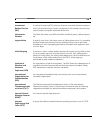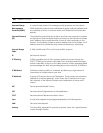
C
GLOSSARY
16 QAM Modulation mode used by the CMTS. QAM uses both amplitude and
phase modulation to encode multiple bits of data in one signaling
element, thus achieving higher data transfer rates than just amplitude or
phase modulation alone.
16 QAM encodes four bits per symbol as one of sixteen possible
amplitude and phase combinations. 16 QAM refers to the number of
discrete phase/amplitude states that are used to represent data bits.
64 QAM A modulation mode used by the CMTS. 64 QAM uses both amplitude
and phase modulation to encode multiple bits of data in one signaling
element. 64 QAM encodes 6 bits per symbol as one of 64 possible
amplitude and phase combinations.
256 QAM A modulation mode used by the CMTS. 256 QAM uses both amplitude
and phase modulation to encode multiple bits of data in one signaling
element. 64 QAM encodes 8 bits per symbol as one of 256 possible
amplitude and phase combinations.
A Record that contains the IP address of the record’s owner. Since hosts may
have multiple IP addresses, multiple A records may match a given domain
name.
Address Resolution
Protocol (ARP)
A protocol for mapping an Internet Protocol address (IP address) to a
physical machine address that is recognized in the local network. For
example, in IP Version 4, the most common level of IP in use today, an
address is 32 bits long. In an Ethernet local area network, however,
addresses for attached devices are 48 bits long. (The physical machine
address is also known as a Media Access Control or MAC address
address.)


















